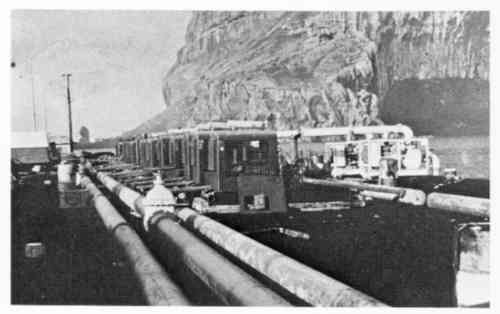Lava-Cooling Operations During the 1973 Eruption of Eldfell Volcano,
Heimaey, Vestmannaeyjar, Iceland
U.S. Geological Survey Open-File Report 97-724
|
|
Figure 8 shows the quantity of water, which was pumped on the lava. It is given in liters per second (I s-1)as a function of the number of days from the start of the eruption [23 January 1973].
As the figure shows, the pumping began on 7 February, or 14 days after the beginning of the volcanic eruption, but on a very small scale. The quantity is considerably increased when the dredge Sandy started to pump (fig. 9). To be sure, the pumping was not continuous as the diagram shows, but it is estimated that it [Sandy] pumped [at a rate] equivalent to 400 I s-1 uninterrupted for more than 10 days. Actually the pumping lasted more than three weeks. It is estimated that the Sandy pumped about 0.4 million metric tonnes of seawater onto the lava up to 23 March, and other pumping equipment [contributed] about 0.1 million metric tonnes.
When the lava flow advanced on 23 March, there was a two-day interruption in the pumping, while the pipes had to be repositioned, but 200 I s-1 were then pumped for 24 hours in between advances of the lava. On 28 March, pumping was started again and from then on it was continuous until the 168th day of the eruption [10 July 1973], when the pumping was terminated. It is estimated that during this time a total of 5.7 million metric tonnes of seawater was pumped after lava started to flow over the town. A total of 6.2 million metric tonnes of seawater was pumped in all. As may be seen from the diagram, the pumping reached its peak on 4 April, when all of the pumping equipment received from the United States had been connected (fig. 10). This quantity gradually decreased. The reason for that is basically that the pipes had to be constantly moved further onto the lava, closer to the crater, so that the pressure drop in the pipes, as well as increased height, caused less efficiency [loss of head due to friction]. Cooling with seawater was stopped around the middle of May, and the quantity decreased about 100 I s-1.
After the middle of June, it was decided to stop the cooling in stages, so that each week one pumping unit was disconnected, and the engines and pumps were cleaned. The first units disconnected pumped comparatively farther onto the lava and, therefore, relatively less quantity than those closer to the town that were stopped later.
Figure 11 shows how much seawater was pumped onto the lava at [10] different locations [on the lava flows]. [Area K was not cooled.] These locations [10 areas: A-J] represent, so to speak, a continuous area measuring about 0.45 square kilometers that corresponds to about a nine-meter-thick layer of lava that has been cooled down to 100 ºC. on the average. However, this does not give a wholly accurate picture, because some places were cooled more than others. The area above the [fish-]processing plants and a lava field just north of the crater were cooled most markedly. Considerable amounts of seawater was also pumped around Flakkarann ["The Wanderer"], that was for a long time moving slightly. On the south side of Flakkarann, there was a large amount of steam rising as a result of convective currents.
Additionally, it may be mentioned that salt accumulated on the lava from the pumping. This
can be easily seen where there are great patches of white on the lava. It is estimated that 220
thousand metric tonnes of salt were deposited on the lava. | ||||||||||||||||||||||||||



